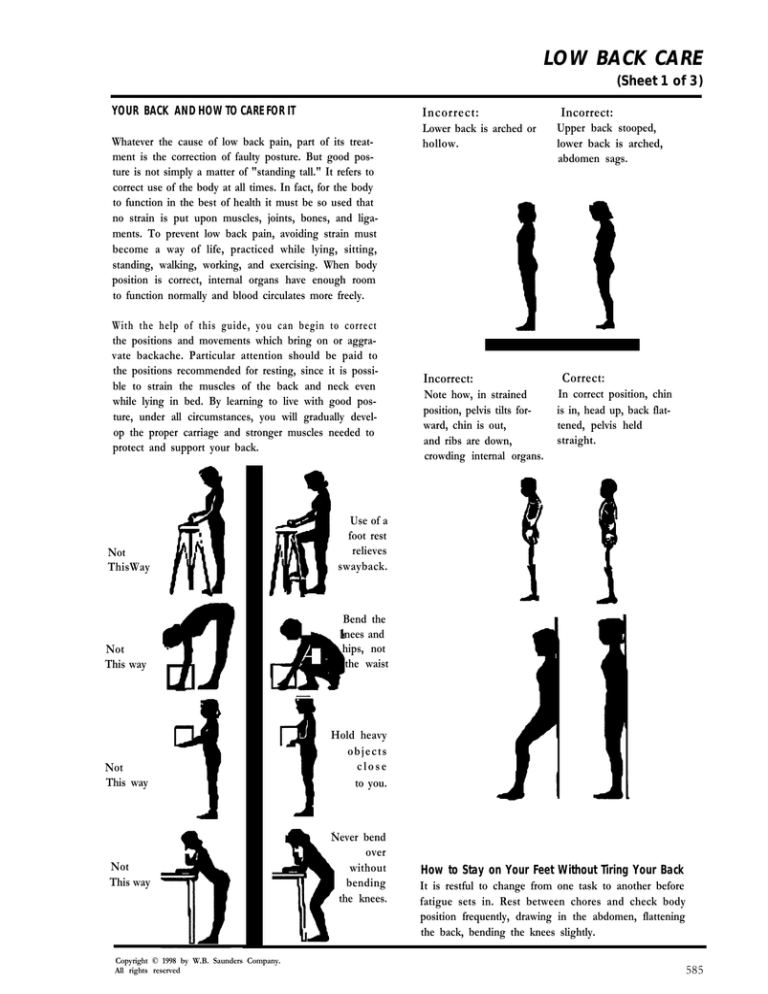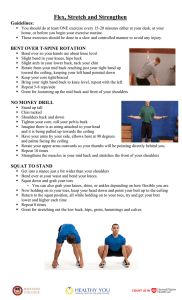
LOW BACK CARE
(Sheet 1 of 3)
YOUR BACK AND HOW TO CARE FOR IT
Incorrect:
Whatever the cause of low back pain, part of its treat­
ment is the correction of faulty posture. But good pos­
ture is not simply a matter of "standing tall." It refers to
correct use of the body at all times. In fact, for the body
to function in the best of health it must be so used that
no strain is put upon muscles, joints, bones, and liga­
ments. To prevent low back pain, avoiding strain must
become a way of life, practiced while lying, sitting,
standing, walking, working, and exercising. When body
position is correct, internal organs have enough room
to function normally and blood circulates more freely.
With the help of this guide, you can begin to correct
the positions and movements which bring on or aggra­
vate backache. Particular attention should be paid to
the positions recommended for resting, since it is possi­
ble to strain the muscles of the back and neck even
while lying in bed. By learning to live with good pos­
ture, under all circumstances, you will gradually devel­
op the proper carriage and stronger muscles needed to
protect and support your back.
Not
ThisWay
Use of a
foot rest
relieves
swayback.
Not
This way
Bend the
knees and
hips, not
the waist
Not
This way
Hold heavy
objects
close
to you.
Not
This way
Copyright © 1998 by W.B. Saunders Company.
All rights reserved
Never bend
over
wit hout
ben ding
the knees.
Lower back is arched or
hollow.
Incorrect:
Note how, in strained
position, pelvis tilts forward, chin is out,
and ribs are down,
crowding internal organs.
Incorrect:
Upper back stooped,
lower back is arched,
abdomen sags.
Correct:
In correct position, chin
is in, head up, back flat-
tened, pelvis held
straight.
How to Stay on Your Feet Without Tiring Your Back
It is restful to change from one task to another before
fatigue sets in. Rest between chores and check body
position frequently, drawing in the abdomen, flattening
the back, bending the knees slightly.
585
LOW BACK CARE
(Sheet 2 of 3)
Check Your Carriage Here
In correct, fully erect posture, a line dropped from the
ear will go through the tip of the shoulder, middle of
hip, back of kneecap, and front of anklebone. To find
the correct standing position: Stand one foot away from
wall. Now sit against wall, bending knees slightly.
Tighten abdominal and buttock muscles. This will tilt
the pelvis back and flatten the lower spine. Holding this
position, inch up the wall to standing position, by
straightening the legs. Now walk around the room,
maintaining the same posture. Place back against wall
again to see if you have held it.
Keep neck and back in
as straight a line as pos­
sible with the spine.
Bend forward from
hips.
Driver’s seat
too far from
pedals empha­
sizes curve in
lower
back.
How to Sit Correctly
A back's best friend is a straight, hard chair. If you can’t
get the chair you prefer, learn to sit properly on what­
ever chair you get. To correct sitting position from for­
ward slump: Throw head back, then bend it forward to
pull in the chin, This will straighten the back. Now
tighten abdominal muscles to raise the chest. Check
position frequently.
How to Put Your Back to Bed
For proper bed posture, a firm mattress is essential.
Bedboards sold commercially or devised at home may
be used with soft mattresses. Bedboards preferably
should be made of 1/4-inch plywood. Faulty sleeping
positions intensify swayback and result not only in
backache but in numbness, tin­
gling, and pain in arms and legs.
Relieve strain by sitting well for­
ward. Flatten back by tightening
abdominal muscles.
Use of footrest
relieves swayback.
Aim is to have knees
higher than hips.
Correct way to sit while
driving, close to pedals. Use seatbelt.
Special backrests available commerci­
ally.
Strain reading position.
Forward thrusting strains mus­
cles of neck and head.
Incorrect:
Correct:
Use of high pillow strains
neck, arms, shoulders.
Sleeping on back is restful and
correct when knees are prop­
erly supported.
Lying flat on back makes
swayback worse.
Lying on side with knees bent
effectively flattens the back.
Flat pillow may be used to sup­
port neck, especially when
shoulders are broad.
Sleeping face down exaggerates swayback, strains neck
and shoulders.
Raise the foot of the mattress
eight inches to discourage
sleeping on the abdomen
Bending one hip and knee
does not relieve swayback.
Proper arrangement of pillows
for resting or reading in bed.
TV slumps lead
to strained neck
and shoulders.
If chair is too high,
swayback is increased.
586
A straight-back chair used
behind a pillow makes a
serviceable backrest.
Copyright © 1998 by W.B. Saunders Company.
All rights reserved.
LOW BACK CARE
(Sheet 3 of 3)
When Doing Nothing, Do It Right
· Rest is the first rule for the tired, painful back. The fol­
lowing positions relieve pain by taking all pressure and
weight off the back and legs.
· Note pillows under knees to relieve strain on the
spine. For complete relief and relaxing effect, these
positions should be maintained from 5 to 25 minutes.
Exercise--Without Attracting Attention
Use these inconspicuous exercises whenever you have
a spare moment during the day, both to relax tension
and improve the tone of important muscle groups.
1. Rotate shoulders forward and backward.
2. Turn head slowly side to side.
3. Watch an imaginary plane take off; just below the
right shoulder. Stretch neck, follow it slowly as it moves
up, around and down, disappearing below the other
shoulder. Repeat, starting on left side.
4. Slowly, slowly, touch left ear to left shoulder; right
ear to right shoulder. Raise both shoulders to touch
ears, drop them as far down as possible.
5. At any pause in the day--waiting for an elevator to
arrive, for a traffic light to change--pull in abdominal
muscles, tighten, hold for the count of eight without
breathing. Relax slowly. Increase the count gradually
after the first week, practice breathing normally with
the abdomen flat and contracted. Do this sitting, stand­
ing, or walking.
Rules to live By--From Now On
Exercise--Without Gelling Out of Bed
Exercises to be performed while lying in bed are aimed
not so much at strengthening muscles, as at teaching
correct positioning. But muscles used correctly become
stronger and in time are able to support the body with
the least amount of effort.
1. Do all exercises in this position. Legs should not be
straightened.
2. Bring knees up to chest. Lower slowly but do not
straighten leg. Relax. Repeat with each leg 10 times.
3. Bring both knees slowly up to chest. Tighten muscles
of abdomen, press back flat against bed. Hold knees to
chest 20 seconds then lower slowly. Relax. Repeat 5
times. This exercise gently stretches the shortened mus­
cles of the lower back, while strengthening abdominal
muscles. Clasp knees, bring them up to chest, at the
same time coming to a sitting position. Rock back and
forth.
Copyright © 1998 by W.B. Saunders Company.
All rights reserved
1. Never bend from the waist only; bend the hips and
knees.
2. Never lift a heavy object higher than your waist.
3. Always turn and face the object you wish to lift.
4. Avoid carrying unbalanced loads; hold heavy objects
close to your body.
5. Carry nothing heavier than you can manage with ease.
6. Never lift or move heavy furniture. Wait for someone
to help or to do it.
7. Avoid sudden movements, or sudden overloading of
muscles. Learn to move deliberately, swinging the legs
from the hips.
8. Learn to keep the head in line with the spine when
standing, sitting or lying in bed.
9. Put soft chairs and deep couches on your “don’t sit”
list. During prolonged sitting, cross your legs to rest
your back.
10. Medical personnel can determine when low back
pain is due to faulty posture and can prescribe proper
exercises.
11. Omit any exercise which arches or overstrains the
lower back, such as backward bends, forward bends,
touching the toes with the knees straight.
12. Women should wear shoes with moderate heels; all
pairs should be about the same height, Avoid changing
from high to low heels.
13. Put a footrest under your desk and another one
under a baby’s crib.
14. Avoid bending over a regular bed to change a baby’s
diaper.
15. Use a rocking chair. Rocking rests the back by
changing the muscle groups used.
16. Train yourself to use your abdominal muscles to flat­
ten your lower abdomen. In time, this muscle contrac­
tion will become habitual.
© Copyright, Schering Corporation, Bloomfield, NJ. Used by
permission.
587



